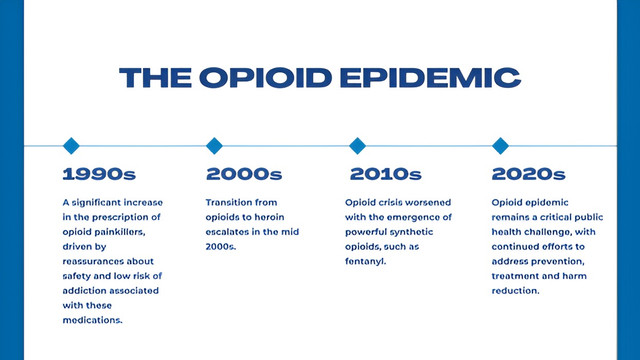A Brief History of the Opioid Epidemic: What, When, How, and the Effects Today

Scott Chappell
Galt Pharmaceuticals Director of Medical Affairs
The opioid epidemic is a complex public health crisis characterized by the widespread misuse and addiction to opioid drugs, including prescription painkillers, heroin, and synthetic opioids, like fentanyl. The epidemic has had devastating consequences, leading to a surge in overdose deaths and profound social and economic impacts.

Background and Early Prescription Trends (1990s)
- What: The opioid epidemic has its roots in the 1990s when there was a significant increase in the prescription of opioid painkillers, driven by reassurances from pharmaceutical companies about the safety and low risk of addiction associated with these medications.
- When: The surge in opioid prescriptions began in the late 1990s.
- How: Pharmaceutical companies, including Purdue Pharma, aggressively marketed opioids like OxyContin to healthcare professionals, downplaying the risks of addiction.
- Citations:
- Van Zee A. The promotion and marketing of OxyContin: commercial triumph, public health tragedy. Am J Public Health. 2009;99(2):221-227.
- Kolodny A, Courtwright DT, Hwang CS, et al. The prescription opioid and heroin crisis: a public health approach to an epidemic of addiction. Annu Rev Public Health. 2015;36:559-574.

Escalation to Heroin (2000s)
- What: As prescription opioid misuse increased, many individuals turned to heroin as a cheaper and more accessible alternative.
- When: The transition from prescription opioids to heroin escalated in the mid-2000s.
- How: Individuals who were addicted to prescription opioids often switched to heroin when their prescriptions ran out or became too expensive.
Rise of Synthetic Opioids (2010s)
- What: The opioid crisis worsened with the emergence of powerful synthetic opioids, particularly fentanyl.
- When: The prevalence of fentanyl increased significantly in the 2010s.
- How: Fentanyl, often illicitly manufactured, began to be mixed with heroin or sold on its own, contributing to a spike in overdose deaths due to its potency.
- Citations:
- Rudd RA, Seth P, David F, Scholl L. Increases in drug and opioid-involved overdose deaths – United States, 2010-2015.
- MMWR Morb Mortal Wkly Rep. 2016;65(5051):1445-1452.
Current Effects and Response (2020s)
- What: The opioid epidemic remains a critical public health challenge, with ongoing efforts to address prevention, treatment, and harm reduction.
- How: Governments, healthcare providers, and communities are working to expand access to addiction treatment, improve prescribing practices, and enhance education about the risks of opioids.
- Citations:
- Substance Abuse and Mental Health Services Administration (SAMHSA). Key Substance Use and Mental Health Indicators in the United States: Results from the 2019 National Survey on Drug Use and Health.
- Centers for Disease Control and Prevention (CDC). Provisional Drug Overdose Death Counts. National Center for Health Statistics.

Impact on Society
The opioid epidemic has had profound social and economic consequences, including strained healthcare systems, increased rates of infectious diseases (e.g., HIV, hepatitis), and a rise in children placed in foster care due to parental substance abuse.
Legal Actions and Litigation
Various lawsuits have been filed against pharmaceutical companies for their role in the opioid epidemic. Purdue Pharma, in particular, faced legal actions, leading to bankruptcy and settlement agreements.
Continued Challenges
Challenges include addressing the stigma associated with addiction, improving access to evidence-based treatment, and finding comprehensive solutions to the social determinants of substance abuse.
While progress has been made in raising awareness and implementing strategies to combat the opioid epidemic, it remains a complex and ongoing public health crisis with multifaceted challenges.






